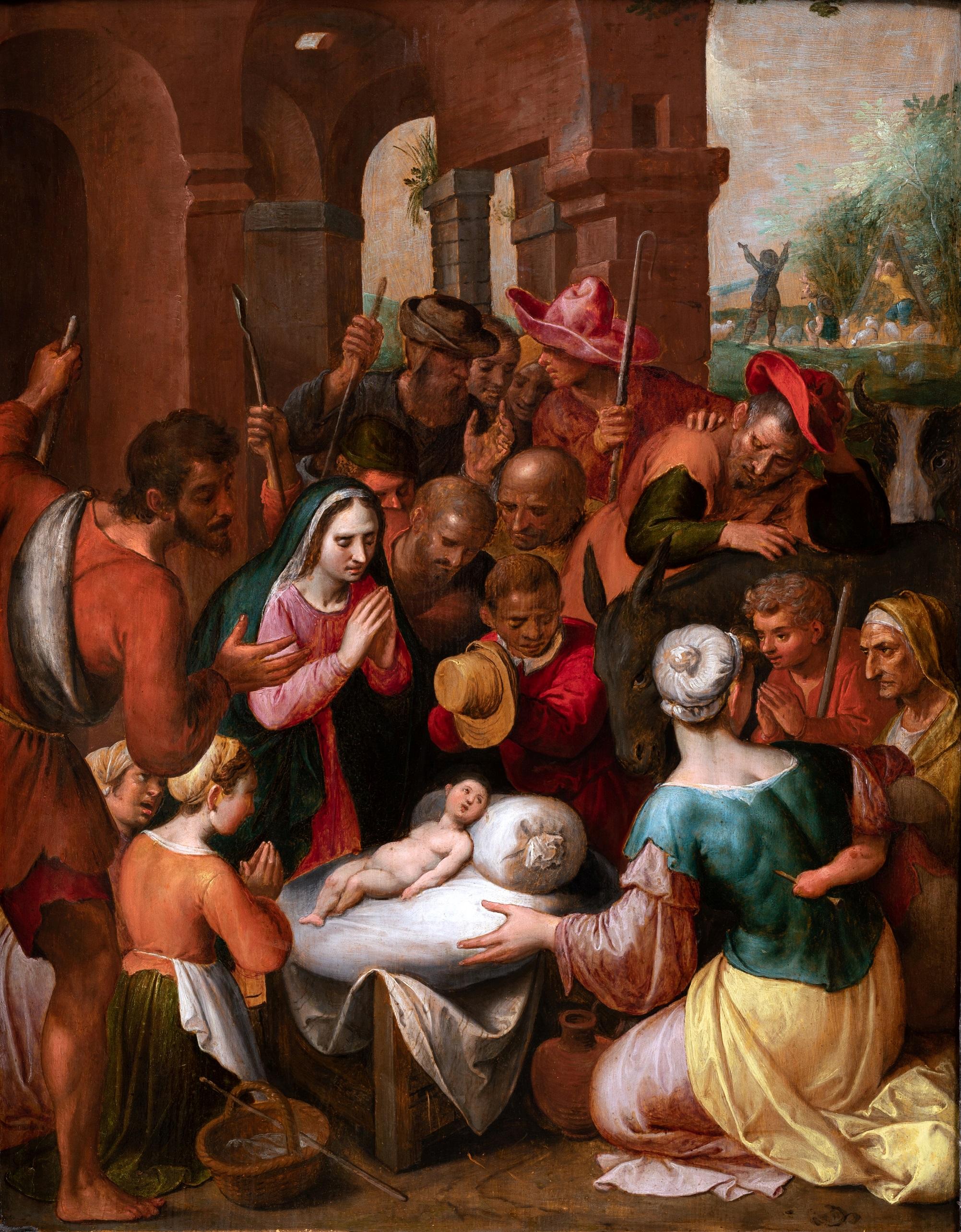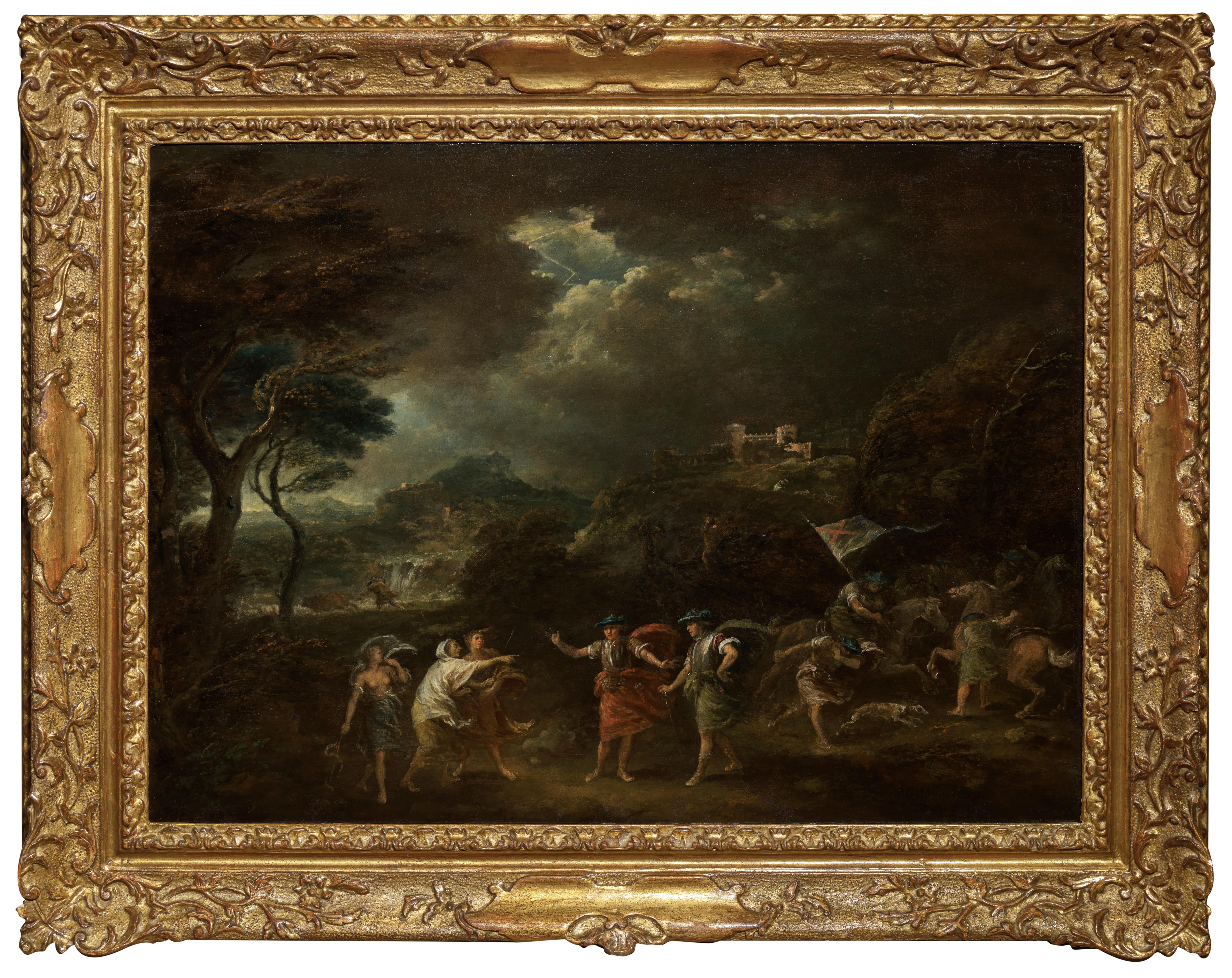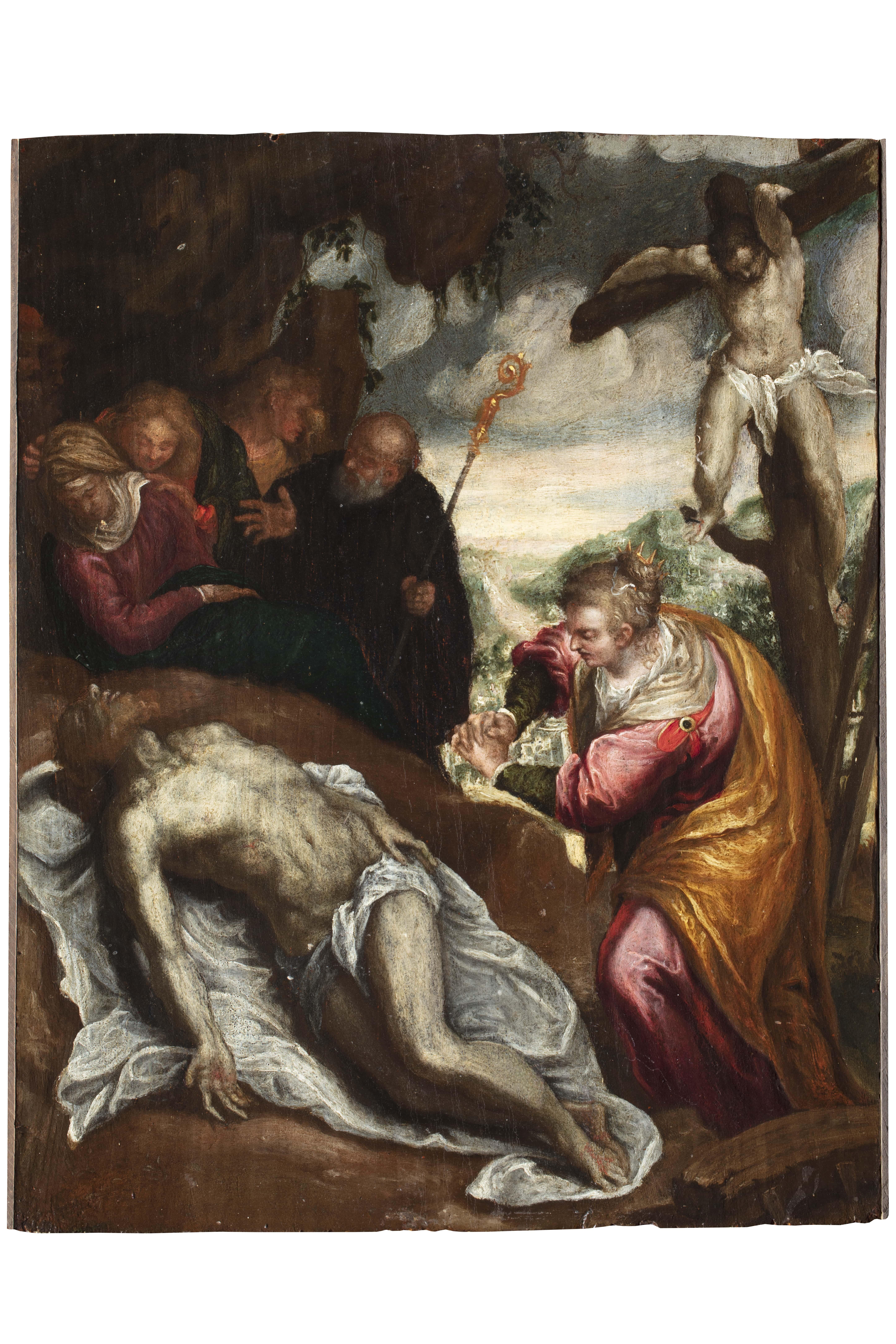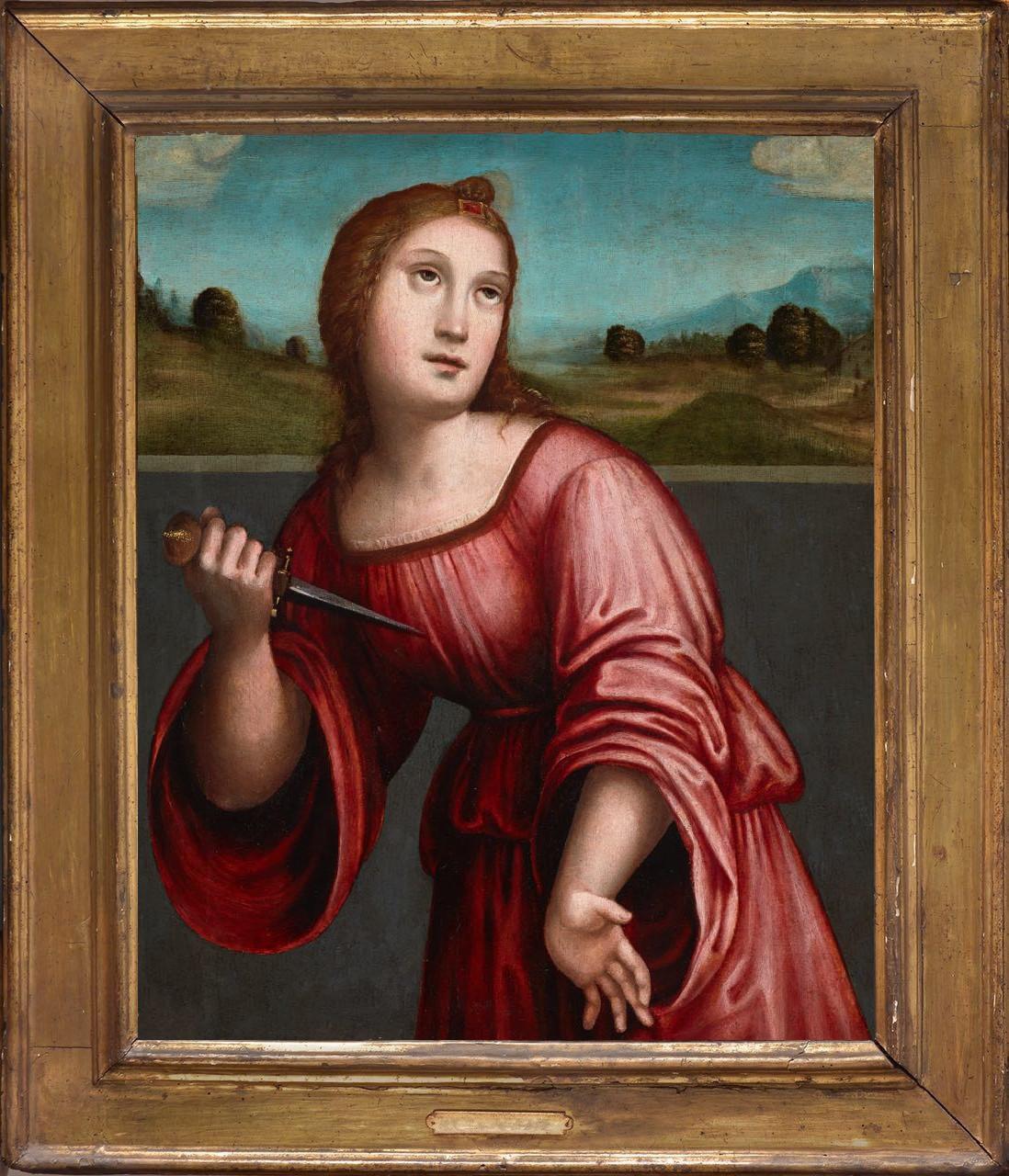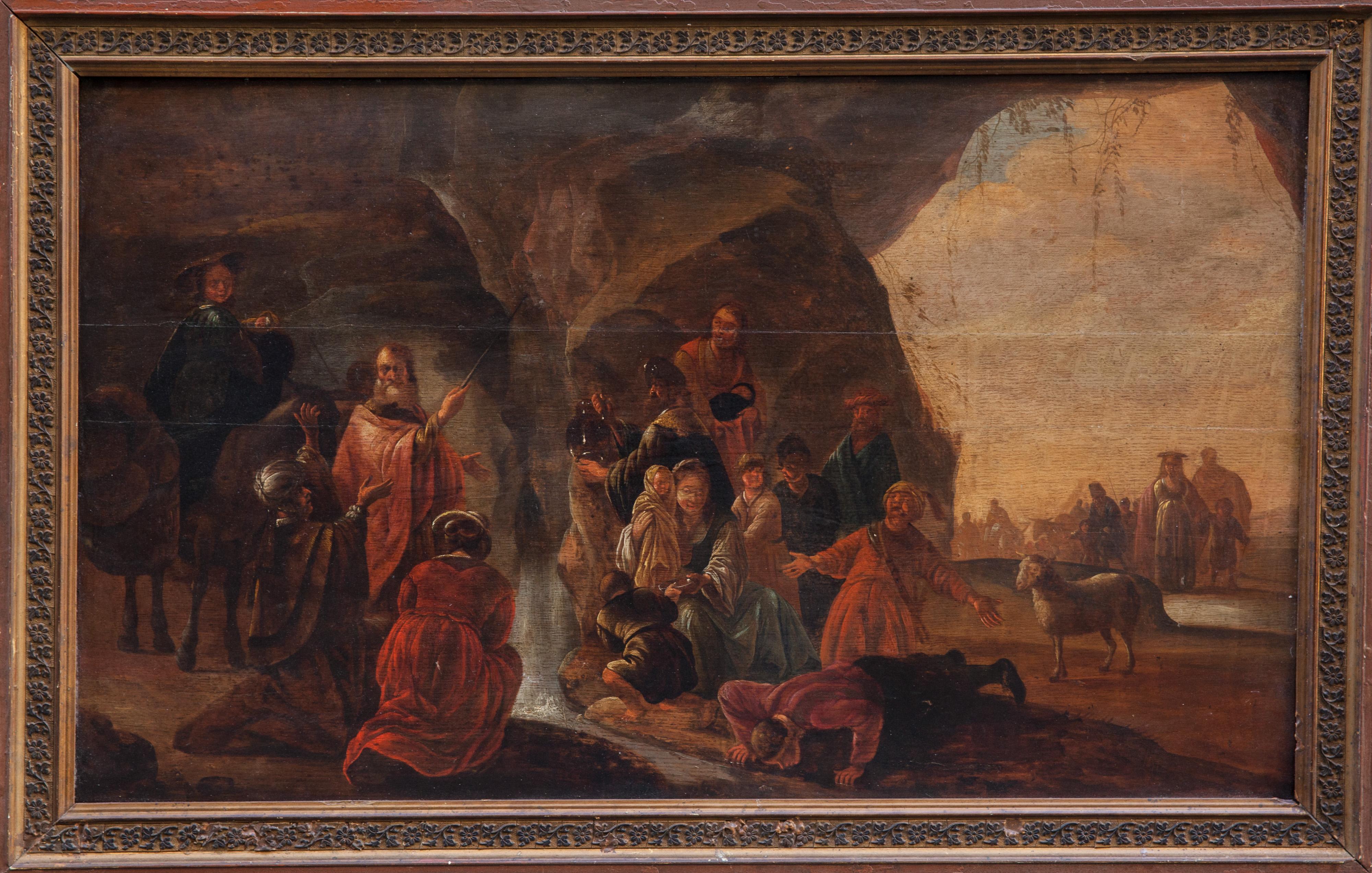Items Similar to Saint Jerome, Antwerp, 16th century, circa 1550, cercle of Lambert Van Noort
Want more images or videos?
Request additional images or videos from the seller
1 of 15
Saint Jerome, Antwerp, 16th century, circa 1550, cercle of Lambert Van Noortcirca 1550
circa 1550
About the Item
Saint Jerome in the desert
Cercle of Lambert Van Noort (1520-1571, Antwerp)
Antwerp School, mid-16th century
Oil on oak panel.
Dimensions: panel h. 69 cm (27.16 in), l. 52.5 cm (20.67 in)
With frame: h. 113 cm, l. 98 cm (44.49x38.58 in)
Very important giltwood tabernacle frame, Italy, 16th century
The life and writings of Saint Jerome were an inexhaustible source of inspiration for artists of the late Middle Ages and the Renaissance.
In Italy and in Nothern Europe, two parallel iconographies are formed, depicting an aged and bearded Saint Jerome. The first showed him near his cave, kneeling before the crucifix, the clothes thrown to the ground. The second represented him in his study, dressed in a red coat in the middle of books and writings.
Our work, dating from the mid-16th century is distinguished by a humanist representation of the saint, the sacred figure is replaced by a simple human being with realistic features. The balding and skeletal old man usually illustrated is replaced here by a younger, muscular man with beautiful hair and beard. This iconographic break will continue throughout 16th century influenced by the humanist movement which developed at that time. During the Renaissance, Saint Jerome became the symbol of the union of Christian faith with the philosophy of Greco-Roman antiquity.
Our artist depicts Saint Jerome sheltered in a cave during his retirement in the desert. In the act of worship and penance, kneeling before the crucifix, he is about to hit himself with a stone, while looking at the sky.
He is dressed in a white blouse (symbol of purity) and wrapped in a large pink cardinal's mantle. His clothes reveal his chest, left arm and knee.
The lion, the saint's companion is lying close to him, he looks at the spectator with his large hazel eyes and surprises by his face with human features.
The crucifix is placed behind a stone slab or an inscription in Gothic letters confirms the identity of the saint. The cardinal's hat is thrown to the ground. A gospel with red cover is placed on the stone.
The saint's face shows fine and regular features, the white hair brushed back revealing the forehead, his mustache and his long beard. His meditative and serene look from his eyes raised to the sky contrasts with the tension of his body, his half-open frozen mouth, his hand tightly squeezing the stone, the swollen muscles, tendons and veins reflecting the bodily resistance of the saint in his act of flogging. An approach illustrating that behind a Saint hides an ordinary man.
This body of a mature man, with protruding muscles surprises by the aristocratic whiteness and the transparency of his skin revealing the bluish veins.
The drapery work is particularly successful, influenced by a strong Gothic influence with broken and angular folds. Strong lighting displays the transitions between light and shade. Gradient colors ranging from purple to white, including all shades of pink distinguish the hollows and ridges. The edges of his tunic are decorated with a pattern made of sgrafitto.
The cave opens onto the landscapes on each side, they are deliberately reproduced at different heights, on the left a hilly landscape with two castles and a hermit chapel at the foot of a mountain, with a winding path in front. On the right, however, a lower area with a fenced building. These landscapes of the Flemish countryside make it possible to position the saint in contemporary space-time for the execution of the work.
Even if the landscape is not the main subject of our painting, it surprises by its precision and realism and takes a certain autonomy in the composition thanks to the process of veduta, opening on the outside environment.
The figure of the saint stands out against the brown background of the cave, the arid land is dotted with small groups of very finely painted vegetation, with carefully drawn leaves and flowers. These vegetal strands are reminiscent of the margins of sheets of Books of hours. An aspect undeniably testifying to the Gothic influence.
The cold palette is dominated by the blue-green shades of the landscape with the icy pink of the tunic. The alternation of color grounds contributes to building the depth: brown for the foreground, green for the second plan, blue for the horizon.
The attention to detail, the modeling of the figure as well as the large sculptural drapes create a work of great sensitivity and great aesthetic quality.
As with many works realized during this era, the identity of our artist remains unknown. However, it is obvious that his source of inspiration lies in the works and several painters from his artistic circle.
The treatment of drapery is very close to the works of Bernard van Orley as well as the crucifix which is identical to that of St Jerome at the museum of Cadiz (Spain), however Van Orley continues to follow the archaic model of an emaciated old man.
Finally the closest work as much by its central figure and its composition with opening onto two landscapes as by its cold palette is a painting resulting from a collaboration between Lambert Van Noort and Henri de Bles (for landscape), St Jerome penitent exposed at the museum of Namur, Belgium. This Saint Jerome displays like that of our painting a healthy, harmonious and muscular body.
It becomes obvious that our work combining two influences and styles marks a new stage in Antwerp painting, a progressive abandonment of the precepts of Gothic art and the archetypes of religious art in favor of Renaissance art guided by the humanist vision and the central place reserved for man.
Very important giltwood tabernacle frame, Italy, 16th century
In richly carved giltwood, shaped in the form of a portico of an ancient temple with fluted pilasters with Ionic capitals belonging to the repertoire of classical architecture. It consists of a large molded cornice and decorated with various friezes of hallmarked flowers followed by an entablature with compartments decorated with a frieze of golden foliage on a black background made with sgrafitto technique. The base is decorated with golden leaf scrolls on a black background. The pedestal is decorated on the front and on the sides with gilt ornament on a black background in sgraffito *.
* Sgrafitto: technique widely used during the Renaissance consisting of applying two layers of paint and scraping the top layer to reveal the patterns of the background.
- Creation Year:circa 1550
- Dimensions:Height: 44.49 in (113.01 cm)Width: 38.58 in (98 cm)Depth: 7 in (17.78 cm)
- Medium:
- Movement & Style:
- Circle Of:Lambert Van Noort (1520 - 1571, Belgian)
- Period:
- Condition:
- Gallery Location:PARIS, FR
- Reference Number:1stDibs: LU2433214025862
About the Seller
No Reviews Yet
Vetted Seller
These experienced sellers undergo a comprehensive evaluation by our team of in-house experts.
1stDibs seller since 2023
Typical response time: 1 hour
- ShippingRetrieving quote...Ships From: PARIS, France
- Return PolicyA return for this item may be initiated within 3 days of delivery.
More From This SellerView All
- Cercle of Ambrosius Francken, Adoration of the shepherds, 17th century AntwerpLocated in PARIS, FRAdoration of the shepherds, Cercle of Ambrosius Francken, Early 17th century Antwerp school Oil on oak panel: h. 55 cm, w. 43 cm (21.65 in x 16.93 in) 17th c. ebonized and moulded f...Category
Early 17th Century Old Masters Figurative Paintings
MaterialsOil, Wood Panel
- Ascension Day in Venice, Louis de Caullery (1582-1621), Flemish 17th centuryLocated in PARIS, FRAscension Day in Venice 17th century Antwerp School Attributed to Louis de Caullery (1582-1621) Oil on oak panel Dimensions: h. 19.68 in, w. 34.25 in Flemish style frame in ebonized ...Category
Early 17th Century Old Masters Landscape Paintings
MaterialsOil, Wood Panel
- 16th century Flemish, Holy Family, workshop of P. Coecke Van Aelst (1502-1550)Located in PARIS, FRRest of the Holy Family during the Flight into Egypt Workshop of Pieter Coecke Van Aelst (1502-1550) 16th century Flemish school Oil on oak panel, Dimensions : panel: h. 34.25 in., ...Category
16th Century Old Masters Figurative Paintings
MaterialsOil, Wood Panel
- The crossing of the Red Sea, 17th century Antwerp, studio Frans FranckenBy Frans Francken IILocated in PARIS, FRCrossing of the Red Sea Workshop of Frans Francken II (1581-1642) 17th century Antwerp School Oil on oak panel Dimensions: h. 49.5 cm, w. 64.5 cm (19.49 in x 25.39 in) Moulded and blackened wooden frame with wide mouldings, with inverted profile from the later period. Framed dimensions: h. 82 cm, w. 97 cm (32.28 x 38.19 in) Our panel illustrates one of the episodes of the Old Testament, recounted in the book of Exodus. After crossing the Red Sea...Category
17th Century Old Masters Figurative Paintings
MaterialsOil, Wood Panel
- Adam and Eve in paradise, studio of Jan Brueghel the Younger, 17th centuryLocated in PARIS, FRStudio of Jan Brueghel the Younger 17th century Antwerp school Oil on oak panel, h. 37 cm, w. 49 cm Tortoiseshell veneered baroque style frame...Category
Mid-17th Century Old Masters Figurative Paintings
MaterialsOil, Wood Panel
- Flemish 17th c., Allegory of war and peace, circa 1630, by Adriaen van StalbemtLocated in PARIS, FRAdriaen van Stalbemt (Antwerp, 1580-1662) Allegory of Peace and War, circa 1620-1630 Oil on oak panel: h. 49.5 cm, l. 73.2cm (19.29 x 28.74 in) Giltwood frame with laurel leaves, Lo...Category
Early 17th Century Old Masters Figurative Paintings
MaterialsOil, Panel
You May Also Like
- 17th Century By Paulus Bor Heraclitus and Democritus Oil on PanelLocated in Milano, Lombardia"Cassetta" frame in ebonized wood. Publications: - Expertise by Prof. Gianni Papi; - G. Papi, Un misto di grano e di pula. Scritti su Caravaggio e l’ambiente caravaggesco, Roma 2...Category
17th Century Old Masters Figurative Paintings
MaterialsOil, Wood Panel
- Macbeth and the Three Witches a Painting on Panel by Francesco ZuccarelliBy Francesco ZuccarelliLocated in PARIS, FRThis painting, created during Zuccarelli's stay in England, represents the decisive moment when Macbeth, together with Banquo, meets the three witches who announce that he will be Ki...Category
1760s Old Masters Landscape Paintings
MaterialsOil, Wood Panel
- 16th Century by Venetian Maestro Deposition of Christ Oil on PanelLocated in Milano, LombardiaFormerly Canesso Collection, Paris. Publications: Bozzetti, modelletti, sketches: dalla collezione di Giorgio Baratti (From the Giorgio Baratti Collection) curated by Anna Orlando, ...Category
16th Century Old Masters Figurative Paintings
MaterialsOil, Wood Panel
- Lucretia, by Giacomo Raibolini Francia. Detto il Francia. Oil on panel, framedLocated in Brooklyn, NYGiacomo used to paint with his brother Giulio, identifying their works with the monogram «I I». The strong influence of his father, Francesco, is undeniable in all his works, althoug...Category
16th Century Old Masters Figurative Paintings
MaterialsOil, Wood Panel
- Moses Strikes the Water from the Rock. XVII cent. Dutch school.Located in Firenze, ITMoses Strikes Water from the Rock Dutch school, XVII century. Workshop of Jacob de Wet (Haarlem, 1610-1675). Technique: Oil on oak wood panel, composed of 3 horizontal panels. In this evocative work, Moses stands in a cave, gathering the Israelites. There was no water to drink or for their cattle. The people were discontented in the desert. But Moses and Aaron listened to the voice of God. With Aaron’s staff, Moses struck the rock, and water gushed forth abundantly, quenching their thirst. Jacob de Wet’s workshop specializes in subjects from the Old and New Testaments. The recognizable rectangular format, simple compositions, and clear narratives define his style. The interplay of light and shadow, reminiscent of Rembrandt, adds timeless allure. The characters’ costumes, with their large hats and turbans...Category
17th Century Old Masters Figurative Paintings
MaterialsOil, Wood Panel
- Fine 17th Century Dutch Old Master Oil on Panel Angelic Visitation to FiguresBy Rembrandt van RijnLocated in Cirencester, GloucestershireThe Angelic Visitation Dutch School, mid 17th century circle of Rembrandt (Dutch 1606-1669) oil on wooden panel, framed in faux tortoiseshell style frame. framed: 25 x 28.75 painting...Category
17th Century Old Masters Figurative Paintings
MaterialsOil, Wood Panel
